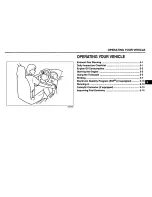
11
MN-831
LoadLifter 5000 Ultimate
fig. 11
fig. 12
Air Line to
Bellows
FF
Vehicle body
or bumper
GG
GG
EE
DD
CC
washer (EE), flat washer (DD), and 5/16 “ nut (GG) and cap (CC). There should be
enough valve exposed after installation - approximately 1/2 “ - to easily apply a pressure
gauge or an air chuck (Figure 11).
5. Push the inflation valve through the hole and use the rubber washer (EE), flat washer
(DD), and another 5/16 “ nut (GG) to secure it in place. Tighten the nuts to secure the
assembly in place (Figure 11).
Option 1
Option 2
6. Route the air line along the frame to the air fitting on the air spring (Figure 12). Keep at
least 6” of clearance between the air line and heat sources, such as the exhaust pipes,
muffler, or catalytic converter. Avoid sharp bends and edges. Use the plastic tie straps
(BB) to secure the air line to fixed, non-moving points along the chassis. Be sure that
the tie straps are tight, but do not pinch the air line. Leave at least 2” of slack to allow
for any movement that might pull on the air line.
7. On the passenger side only, place the provided thermal sleeve (S) on the air line near
the exhaust.
8. Cut off air line leaving approximately 12” of extra air line. A clean square cut will ensure
against leaks. Insert the air line into the air fitting. This is a push to connect fitting. Simply
push the air line into the 90° swivel fitting until it bottoms out (9/16” of air line should be
in the fitting).
9. Install the minimum/maximum air pressure decal in a highly visible location. We suggest
placing it on the driver’s side window just above the door handle.










































